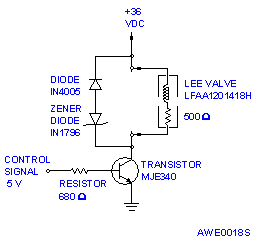Before I begin, I am completely out of my element in this project, so my apologies if I don't use correct terminology.
I am trying to control a microliter dispensing valve using a relay control circuit. This circuit needs to be fast, as I need the droplet sizes to be very small. My digital IO controller outputs a 5V TTL signal, which used to drive a 5V reed relay (with a 51V zener diode parallel to the relay for protection). The common pin of the relay is connected to a +13.8VDC 3A power supply, and the normally open pin is connected to the positive end of the dispensing valve. The negative end of the valve connects to the negative end of the power supply. The valve is supposed to be driven by 12V, with a threshold current of 0.209 mA.
With the reed relay, I was able to get a decent dot size of around 5 mm, but this valve is supposed to be able to make dot sizes smaller than that. Therefore, I switched over to a solid state relay (input is 5V; output is 120VAC 1.6A) in an attempt to possibly make the circuit respond faster.
However, following the same wiring scheme as with the reed relay, my results were not what I expected. The relay closes with no problem. However, once the relay is in the closed position, it appears to be stuck in the closed position even when the 5V input is cut off. If I remove the valve and just put a voltmeter to see what's going on, the circuit acts as expected. What's going on?
Did I choose the wrong kind of SSR relay, or is there something wrong with my wiring or choice of power source?
I am trying to control a microliter dispensing valve using a relay control circuit. This circuit needs to be fast, as I need the droplet sizes to be very small. My digital IO controller outputs a 5V TTL signal, which used to drive a 5V reed relay (with a 51V zener diode parallel to the relay for protection). The common pin of the relay is connected to a +13.8VDC 3A power supply, and the normally open pin is connected to the positive end of the dispensing valve. The negative end of the valve connects to the negative end of the power supply. The valve is supposed to be driven by 12V, with a threshold current of 0.209 mA.
With the reed relay, I was able to get a decent dot size of around 5 mm, but this valve is supposed to be able to make dot sizes smaller than that. Therefore, I switched over to a solid state relay (input is 5V; output is 120VAC 1.6A) in an attempt to possibly make the circuit respond faster.
However, following the same wiring scheme as with the reed relay, my results were not what I expected. The relay closes with no problem. However, once the relay is in the closed position, it appears to be stuck in the closed position even when the 5V input is cut off. If I remove the valve and just put a voltmeter to see what's going on, the circuit acts as expected. What's going on?
Did I choose the wrong kind of SSR relay, or is there something wrong with my wiring or choice of power source?


![[colorface] [colorface] [colorface]](/data/assets/smilies/colorface.gif)

